Analyzing Key Differences Between Management and Financial Accounting
VerifiedAdded on 2023/01/11
|6
|1154
|94
Essay
AI Summary
This essay provides a detailed comparison between Management Accounting (MA) and Financial Accounting (FA), emphasizing their differences in systems, reporting focus, aggregation, efficiency, timing, information sources, standards, time period orientation, and valuation. It further discusses the usefulness of financial information for various users, including managers, shareholders, investors, banks, suppliers, competitors, government, employees, and the public, highlighting how each group utilizes financial reports for decision-making and assessment. The essay references academic sources to support its analysis of the roles and implications of both accounting approaches in business finance.

BUSINESS FINANCE
Paraphrase This Document
Need a fresh take? Get an instant paraphrase of this document with our AI Paraphraser
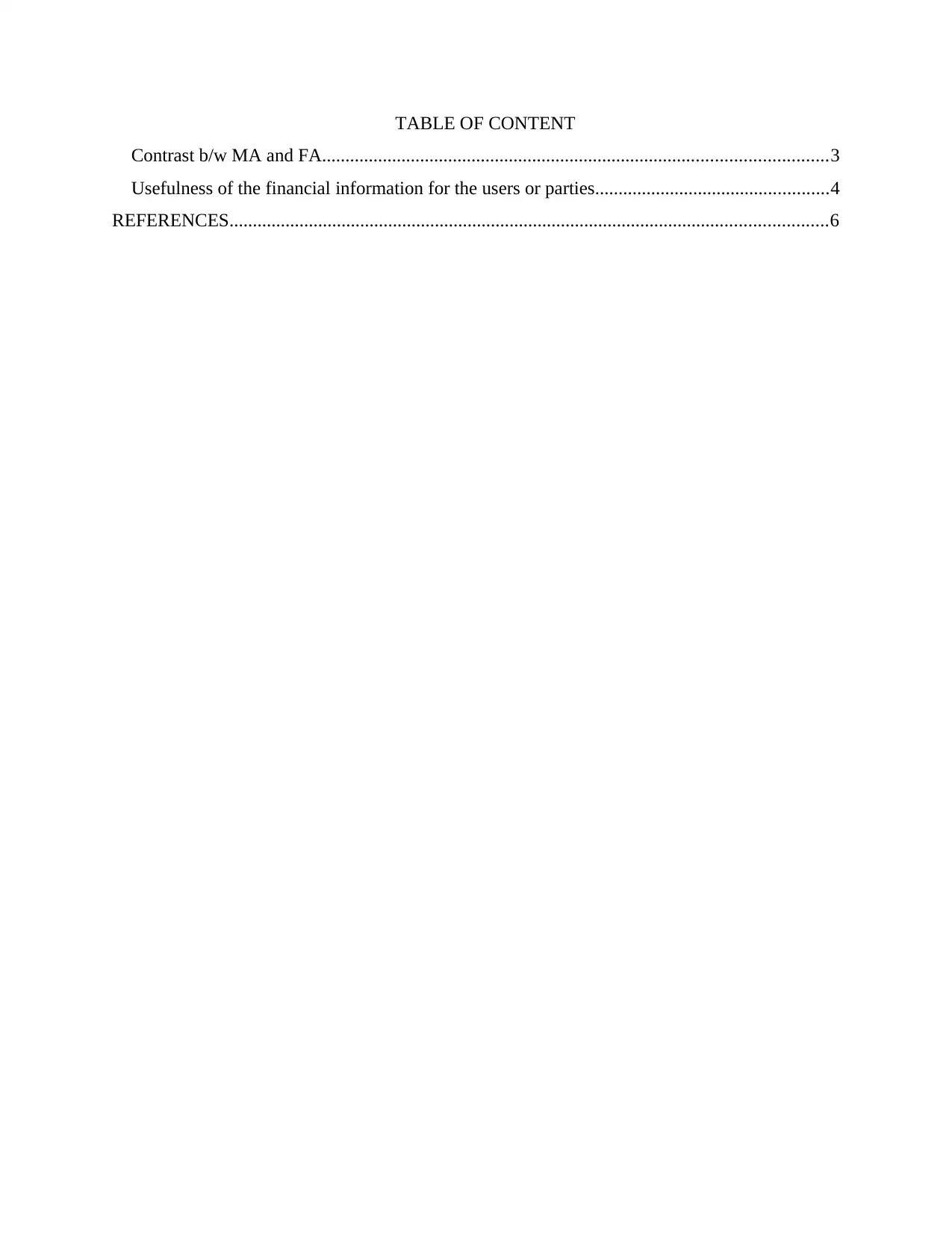
TABLE OF CONTENT
Contrast b/w MA and FA............................................................................................................3
Usefulness of the financial information for the users or parties..................................................4
REFERENCES................................................................................................................................6
Contrast b/w MA and FA............................................................................................................3
Usefulness of the financial information for the users or parties..................................................4
REFERENCES................................................................................................................................6
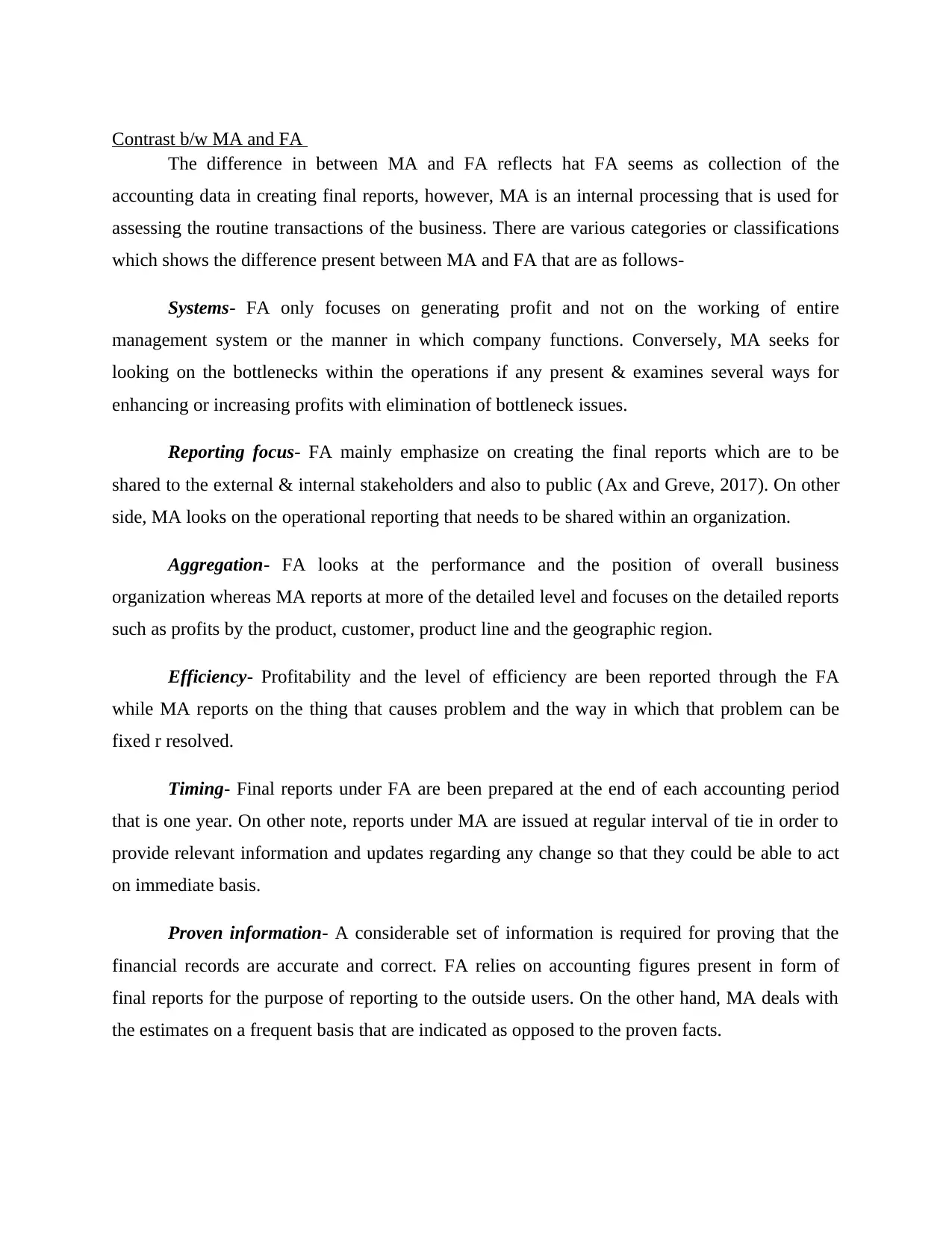
Contrast b/w MA and FA
The difference in between MA and FA reflects hat FA seems as collection of the
accounting data in creating final reports, however, MA is an internal processing that is used for
assessing the routine transactions of the business. There are various categories or classifications
which shows the difference present between MA and FA that are as follows-
Systems- FA only focuses on generating profit and not on the working of entire
management system or the manner in which company functions. Conversely, MA seeks for
looking on the bottlenecks within the operations if any present & examines several ways for
enhancing or increasing profits with elimination of bottleneck issues.
Reporting focus- FA mainly emphasize on creating the final reports which are to be
shared to the external & internal stakeholders and also to public (Ax and Greve, 2017). On other
side, MA looks on the operational reporting that needs to be shared within an organization.
Aggregation- FA looks at the performance and the position of overall business
organization whereas MA reports at more of the detailed level and focuses on the detailed reports
such as profits by the product, customer, product line and the geographic region.
Efficiency- Profitability and the level of efficiency are been reported through the FA
while MA reports on the thing that causes problem and the way in which that problem can be
fixed r resolved.
Timing- Final reports under FA are been prepared at the end of each accounting period
that is one year. On other note, reports under MA are issued at regular interval of tie in order to
provide relevant information and updates regarding any change so that they could be able to act
on immediate basis.
Proven information- A considerable set of information is required for proving that the
financial records are accurate and correct. FA relies on accounting figures present in form of
final reports for the purpose of reporting to the outside users. On the other hand, MA deals with
the estimates on a frequent basis that are indicated as opposed to the proven facts.
The difference in between MA and FA reflects hat FA seems as collection of the
accounting data in creating final reports, however, MA is an internal processing that is used for
assessing the routine transactions of the business. There are various categories or classifications
which shows the difference present between MA and FA that are as follows-
Systems- FA only focuses on generating profit and not on the working of entire
management system or the manner in which company functions. Conversely, MA seeks for
looking on the bottlenecks within the operations if any present & examines several ways for
enhancing or increasing profits with elimination of bottleneck issues.
Reporting focus- FA mainly emphasize on creating the final reports which are to be
shared to the external & internal stakeholders and also to public (Ax and Greve, 2017). On other
side, MA looks on the operational reporting that needs to be shared within an organization.
Aggregation- FA looks at the performance and the position of overall business
organization whereas MA reports at more of the detailed level and focuses on the detailed reports
such as profits by the product, customer, product line and the geographic region.
Efficiency- Profitability and the level of efficiency are been reported through the FA
while MA reports on the thing that causes problem and the way in which that problem can be
fixed r resolved.
Timing- Final reports under FA are been prepared at the end of each accounting period
that is one year. On other note, reports under MA are issued at regular interval of tie in order to
provide relevant information and updates regarding any change so that they could be able to act
on immediate basis.
Proven information- A considerable set of information is required for proving that the
financial records are accurate and correct. FA relies on accounting figures present in form of
final reports for the purpose of reporting to the outside users. On the other hand, MA deals with
the estimates on a frequent basis that are indicated as opposed to the proven facts.
⊘ This is a preview!⊘
Do you want full access?
Subscribe today to unlock all pages.

Trusted by 1+ million students worldwide
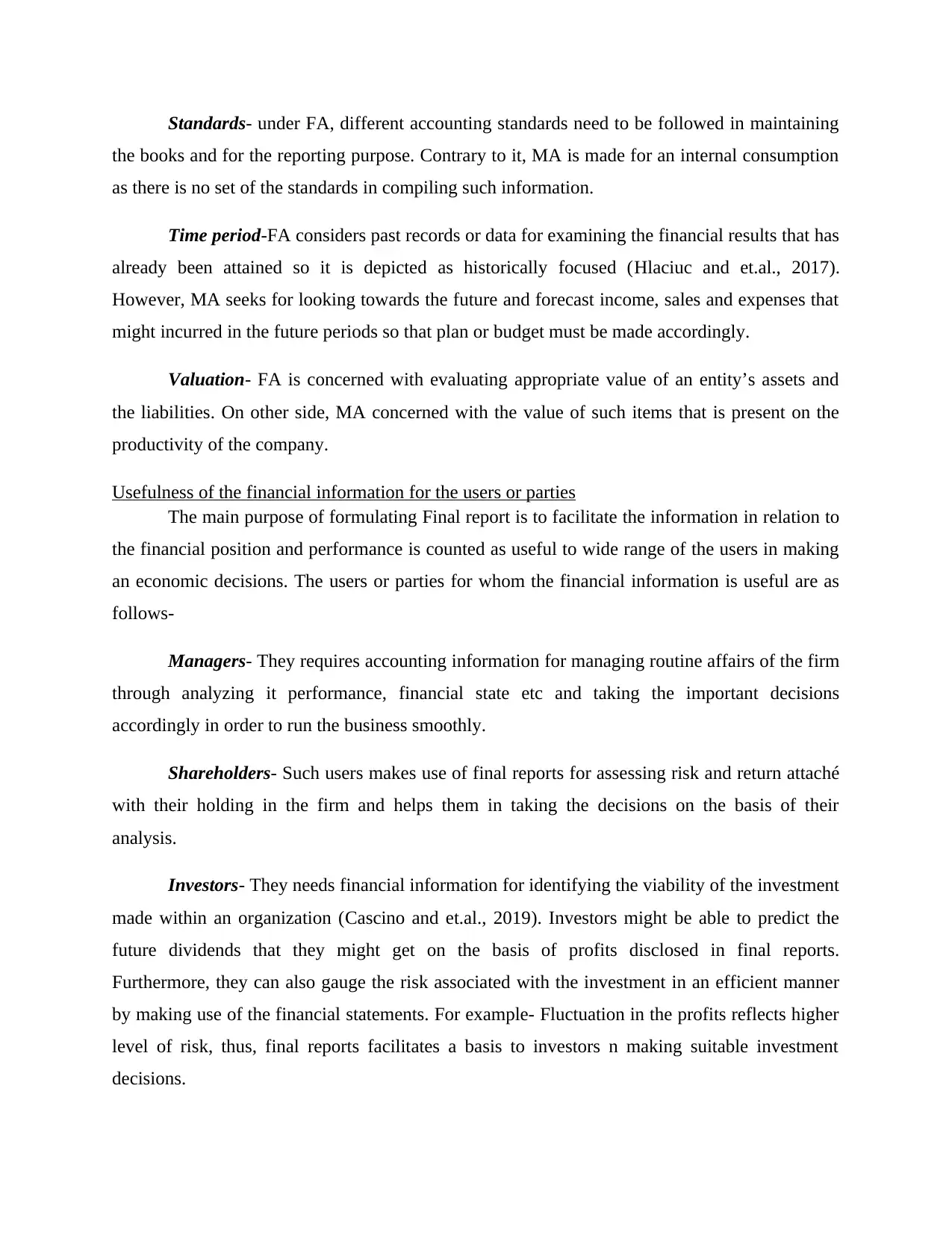
Standards- under FA, different accounting standards need to be followed in maintaining
the books and for the reporting purpose. Contrary to it, MA is made for an internal consumption
as there is no set of the standards in compiling such information.
Time period-FA considers past records or data for examining the financial results that has
already been attained so it is depicted as historically focused (Hlaciuc and et.al., 2017).
However, MA seeks for looking towards the future and forecast income, sales and expenses that
might incurred in the future periods so that plan or budget must be made accordingly.
Valuation- FA is concerned with evaluating appropriate value of an entity’s assets and
the liabilities. On other side, MA concerned with the value of such items that is present on the
productivity of the company.
Usefulness of the financial information for the users or parties
The main purpose of formulating Final report is to facilitate the information in relation to
the financial position and performance is counted as useful to wide range of the users in making
an economic decisions. The users or parties for whom the financial information is useful are as
follows-
Managers- They requires accounting information for managing routine affairs of the firm
through analyzing it performance, financial state etc and taking the important decisions
accordingly in order to run the business smoothly.
Shareholders- Such users makes use of final reports for assessing risk and return attaché
with their holding in the firm and helps them in taking the decisions on the basis of their
analysis.
Investors- They needs financial information for identifying the viability of the investment
made within an organization (Cascino and et.al., 2019). Investors might be able to predict the
future dividends that they might get on the basis of profits disclosed in final reports.
Furthermore, they can also gauge the risk associated with the investment in an efficient manner
by making use of the financial statements. For example- Fluctuation in the profits reflects higher
level of risk, thus, final reports facilitates a basis to investors n making suitable investment
decisions.
the books and for the reporting purpose. Contrary to it, MA is made for an internal consumption
as there is no set of the standards in compiling such information.
Time period-FA considers past records or data for examining the financial results that has
already been attained so it is depicted as historically focused (Hlaciuc and et.al., 2017).
However, MA seeks for looking towards the future and forecast income, sales and expenses that
might incurred in the future periods so that plan or budget must be made accordingly.
Valuation- FA is concerned with evaluating appropriate value of an entity’s assets and
the liabilities. On other side, MA concerned with the value of such items that is present on the
productivity of the company.
Usefulness of the financial information for the users or parties
The main purpose of formulating Final report is to facilitate the information in relation to
the financial position and performance is counted as useful to wide range of the users in making
an economic decisions. The users or parties for whom the financial information is useful are as
follows-
Managers- They requires accounting information for managing routine affairs of the firm
through analyzing it performance, financial state etc and taking the important decisions
accordingly in order to run the business smoothly.
Shareholders- Such users makes use of final reports for assessing risk and return attaché
with their holding in the firm and helps them in taking the decisions on the basis of their
analysis.
Investors- They needs financial information for identifying the viability of the investment
made within an organization (Cascino and et.al., 2019). Investors might be able to predict the
future dividends that they might get on the basis of profits disclosed in final reports.
Furthermore, they can also gauge the risk associated with the investment in an efficient manner
by making use of the financial statements. For example- Fluctuation in the profits reflects higher
level of risk, thus, final reports facilitates a basis to investors n making suitable investment
decisions.
Paraphrase This Document
Need a fresh take? Get an instant paraphrase of this document with our AI Paraphraser
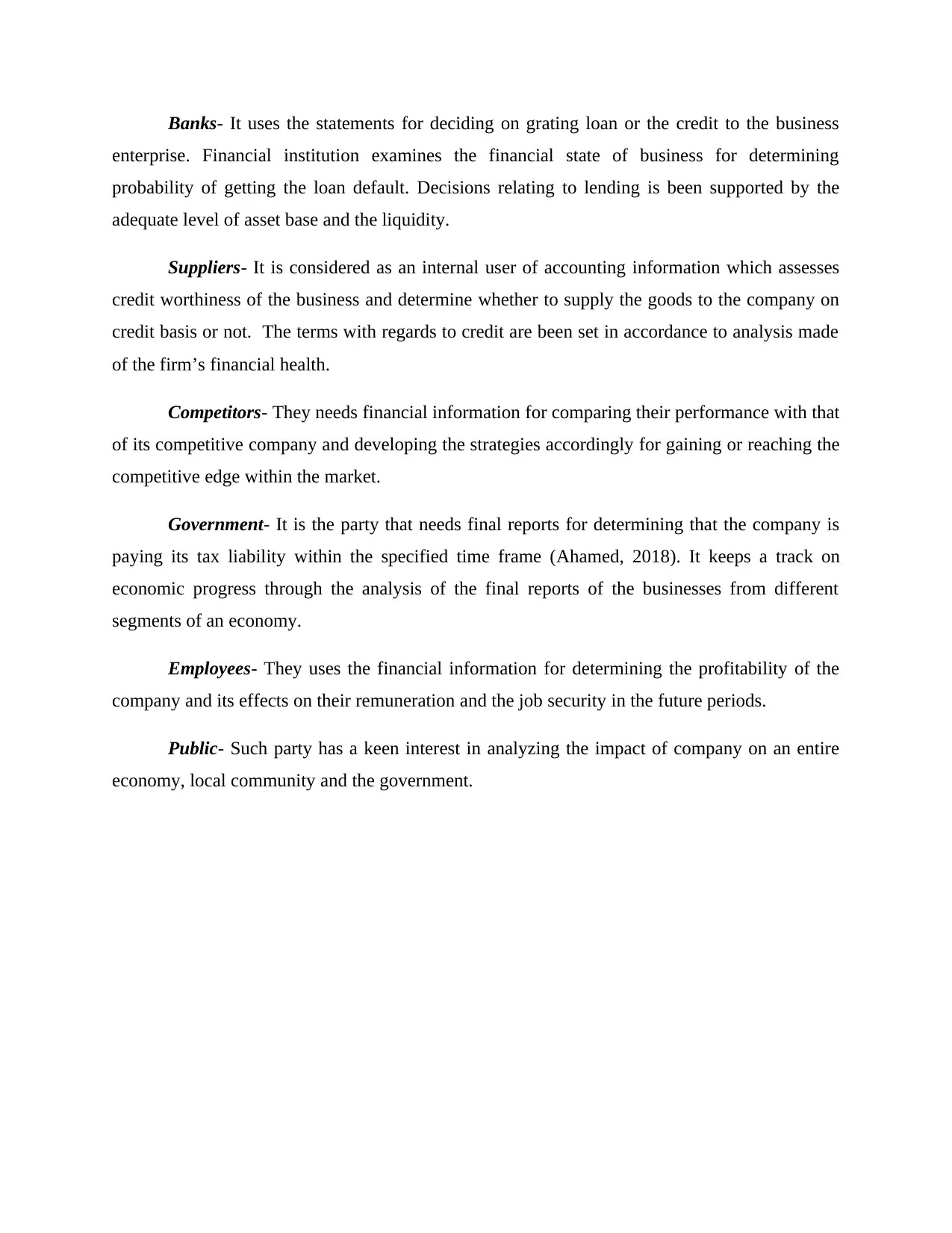
Banks- It uses the statements for deciding on grating loan or the credit to the business
enterprise. Financial institution examines the financial state of business for determining
probability of getting the loan default. Decisions relating to lending is been supported by the
adequate level of asset base and the liquidity.
Suppliers- It is considered as an internal user of accounting information which assesses
credit worthiness of the business and determine whether to supply the goods to the company on
credit basis or not. The terms with regards to credit are been set in accordance to analysis made
of the firm’s financial health.
Competitors- They needs financial information for comparing their performance with that
of its competitive company and developing the strategies accordingly for gaining or reaching the
competitive edge within the market.
Government- It is the party that needs final reports for determining that the company is
paying its tax liability within the specified time frame (Ahamed, 2018). It keeps a track on
economic progress through the analysis of the final reports of the businesses from different
segments of an economy.
Employees- They uses the financial information for determining the profitability of the
company and its effects on their remuneration and the job security in the future periods.
Public- Such party has a keen interest in analyzing the impact of company on an entire
economy, local community and the government.
enterprise. Financial institution examines the financial state of business for determining
probability of getting the loan default. Decisions relating to lending is been supported by the
adequate level of asset base and the liquidity.
Suppliers- It is considered as an internal user of accounting information which assesses
credit worthiness of the business and determine whether to supply the goods to the company on
credit basis or not. The terms with regards to credit are been set in accordance to analysis made
of the firm’s financial health.
Competitors- They needs financial information for comparing their performance with that
of its competitive company and developing the strategies accordingly for gaining or reaching the
competitive edge within the market.
Government- It is the party that needs final reports for determining that the company is
paying its tax liability within the specified time frame (Ahamed, 2018). It keeps a track on
economic progress through the analysis of the final reports of the businesses from different
segments of an economy.
Employees- They uses the financial information for determining the profitability of the
company and its effects on their remuneration and the job security in the future periods.
Public- Such party has a keen interest in analyzing the impact of company on an entire
economy, local community and the government.
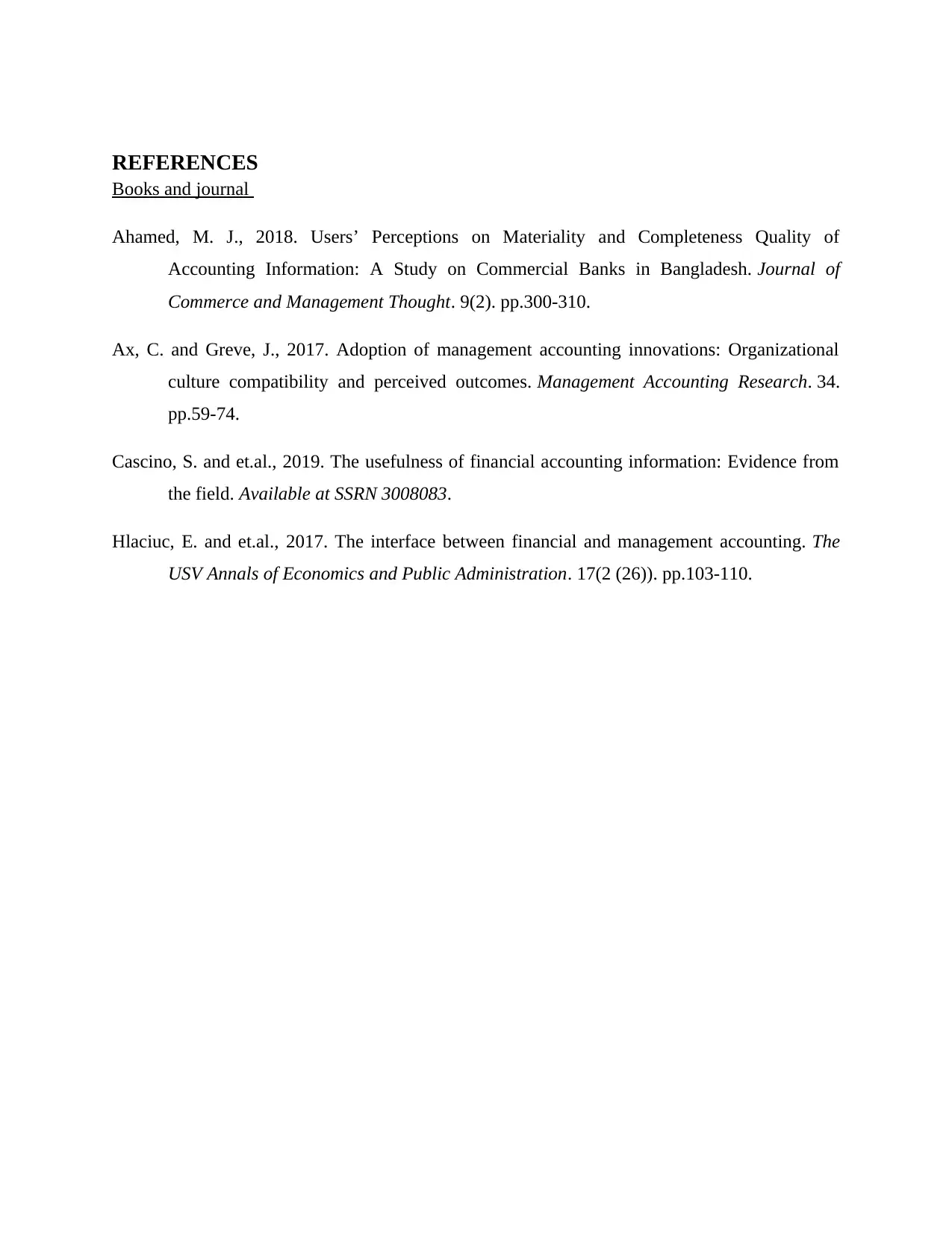
REFERENCES
Books and journal
Ahamed, M. J., 2018. Users’ Perceptions on Materiality and Completeness Quality of
Accounting Information: A Study on Commercial Banks in Bangladesh. Journal of
Commerce and Management Thought. 9(2). pp.300-310.
Ax, C. and Greve, J., 2017. Adoption of management accounting innovations: Organizational
culture compatibility and perceived outcomes. Management Accounting Research. 34.
pp.59-74.
Cascino, S. and et.al., 2019. The usefulness of financial accounting information: Evidence from
the field. Available at SSRN 3008083.
Hlaciuc, E. and et.al., 2017. The interface between financial and management accounting. The
USV Annals of Economics and Public Administration. 17(2 (26)). pp.103-110.
Books and journal
Ahamed, M. J., 2018. Users’ Perceptions on Materiality and Completeness Quality of
Accounting Information: A Study on Commercial Banks in Bangladesh. Journal of
Commerce and Management Thought. 9(2). pp.300-310.
Ax, C. and Greve, J., 2017. Adoption of management accounting innovations: Organizational
culture compatibility and perceived outcomes. Management Accounting Research. 34.
pp.59-74.
Cascino, S. and et.al., 2019. The usefulness of financial accounting information: Evidence from
the field. Available at SSRN 3008083.
Hlaciuc, E. and et.al., 2017. The interface between financial and management accounting. The
USV Annals of Economics and Public Administration. 17(2 (26)). pp.103-110.
⊘ This is a preview!⊘
Do you want full access?
Subscribe today to unlock all pages.

Trusted by 1+ million students worldwide
1 out of 6
Related Documents
Your All-in-One AI-Powered Toolkit for Academic Success.
+13062052269
info@desklib.com
Available 24*7 on WhatsApp / Email
![[object Object]](/_next/static/media/star-bottom.7253800d.svg)
Unlock your academic potential
Copyright © 2020–2025 A2Z Services. All Rights Reserved. Developed and managed by ZUCOL.





